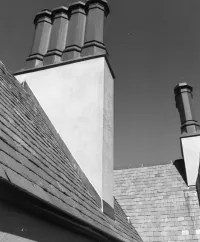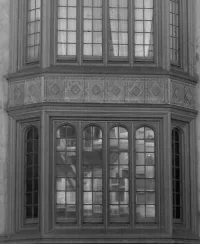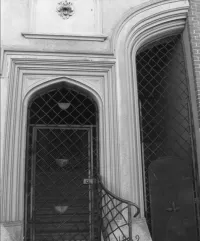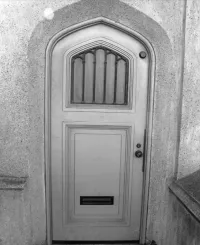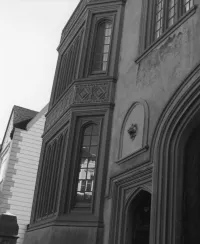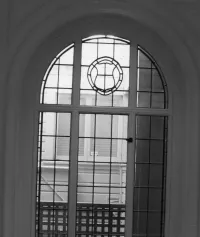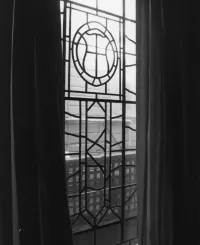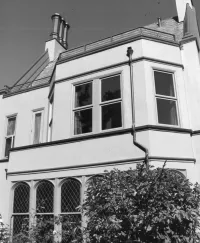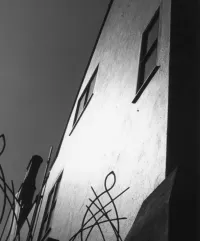Share what you know,
and discover more.
Share what you know,
and discover more.
Oct 05, 2009
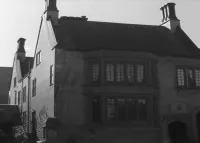
-

- Charmaine Bantugan
Tobin House (1969 California Street) - National Register of Historic Places
Statement of Significance: The Tobin House, located at 1969 California Street, is eligible for the National Register of Historic Places at the local level under Criterion C, as the work of a master architect. Willis Polk, one of the San Francisco Bay Area’s most influential architects of the period, designed the house for Constance de Young and Joseph O. Tobin, descendants of two of San Francisco’s most prominent families. It is representative of Polk’s penchant for medieval English architecture and restrained use of decoration as panaceas for what he deemed the architectural chaos of San Francisco’s late nineteenth-century streetscape. The house also influenced the architectural development of the block during the 1940s and is unique in San Francisco - let alone Polk’s oeuvre -for a Gothic-style half arch that leads to a side yard to the west of the house. Background In July 1911, Michael H. de Young (1849-1925), co-founder of the San Francisco Chronicle, purchased lots fifteen and sixteen of San Francisco block number 649. They are located on the south side of California Street, between Gough and Octavia Streets, directly adjacent to the former site of his own estate on lots seventeen through twenty. Technically located in the Western Addition of San Francisco, these lots stand on the popular boundary line of the Western Addition and Pacific Heights neighborhoods. In August 1911, de Young transferred the deed to the lots to his daughters Helen M. Cameron, wife of George E. Cameron, and Constance M. Tobin, wife of Joseph O. Tobin, an executive at Hibernia Bank and member of one of San Francisco’s oldest and wealthiest families. Michael de Young also offered to build homes on these lots for his daughters and their young families, but for years nothing happened. Both the Tobin and Cameron families chose instead to live along the peninsula, in affluent towns south of San Francisco. Tragedy struck the de young family in 1913, which eventually prompted the development of 1969 California Street. Katherine de Young, the matriarch of the family, fell ill with cancer that year, the same year that her only son, thirty-two-year-old Charley, died suddenly of typhoid fever. Emotionally heart broken and physically stricken with cancer of the spine and kidneys, Katherine de Young died in 1917. According to one of the four surviving daughters, Helen de Young Cameron, the four girls “made it a point never to leave Father alone” during their mother’s illness or after her death. It was during this period, in 1914, that Constance and Joseph O. Tobin decided to take up M. H. de Young’s offer to build a house on lot sixteen, directly adjacent to the de Young mansion. One of the most influential architects in the San Francisco Bay Area, Willis Polk, designed the new house, a three-story and basement frame structure in the Tudor Gothic Revival style clad with cement plaster over metal lath. Originally, Polk conceived of the house as a twin and designed a full Gothic arch, half of which adorns the western end of the fa9ade of the Tobin house. A bridge connected the Tobin and de Young properties. Constance and Joseph O. Tobin lived with their family in the house from 1915 to 1927. Shortly after M. H. de Young died, the Tobins relocated to the peninsula, where both Constance and Joseph had sisters who were living on estates in the affluent suburbs of San Mateo, Hillsborough, and Burlingame. It is not clear how the house was used or by whom, but the Tobins did not sell 1969 California Street at this time. M. H. de Young’s four daughters maintained the old Victorian next door for family gatherings until the late 1930s, by which time the mansion was in dire need of expensive repairs and servants were difficult to find. They decided to sell the mansion in 1940. When one potential buyer proposed to turn it into a boarding house, however, the de Young daughters decided to hand over the mansion to a developer’s wrecking ball. Helen de Young Cameron sold her lot to the west of the Tobin house at this time too, thus ensuring that Willis Polk’s design was never going to be completed. The remaining half arch thus serves as permanent reminder of M. H. de Young’s intentions to have two of his daughters live next to the old family estate. Constance de Young Tobin also purchased a portion of M. H. de Young’s property from the developers in 1940; the space that is now the driveway and upon which the single-story addition now stands. No documents are currently available to determine what this space looked like, how it was used before the Tobins purchased it, or how they intended to use it. The parcel also included one decorative concrete lamppost base that had marked off the de Young property. These elements of block 649, now part of lot 16, are the last surviving remnants of M. H. de Young’s residential estate. Context C: Architecture Master architect Willis Jefferson Polk (1867-1924) designed the Tobin House. Trained through apprenticeships, Polk rose to become arguably the most influential architect in the San Francisco Bay Area during the first quarter of the twentieth century. He helped revolutionize domestic architecture with his contribution to the Bay Region Style, and he played a pivotal role in the architectural aesthetic and urban planning program for the City of San Francisco following the earthquake and fires of 1906. The Tobin House can be understood as an example of Willis Polk’s critique against the ostentation of nineteenth-century Victorian San Francisco. It is also one of the most distinctive urban residences that Polk designed throughout his career. Willis Polk was born in 1867 in Jackson, Illinois, to William Webb Polk, an itinerant carpenter who eventually established a prosperous business in St. Louis, Missouri. The younger Polk began his architectural training in a local contractor’s office when he was just eight years old, then graduated to work in his father’s office as a teenager. In 1887 Polk joined the prominent Boston firm of Van Brunt & Howe as an employee in their new office in Kansas City, Missouri. Under their tutelage, he began to understand architecture as an art rather than a trade and was introduced to academic eclecticism. Within years, the budding architect moved on to New York City, where he audited courses taught by William Robert Ware at Columbia University and worked in the office of A. Page Brown. Though he did not work with them, Polk also came to know preeminent architects McKim, Mead & White as well as many of the young protegees working in their office. The most influential idea that Polk took away from his association with this famous firm was that an architect should aspire to create beautiful buildings. When A. Page Brown relocated to San Francisco, Polk followed and took his aspirations for beauty with him. During the 1890s the young Willis Polk established himself as a vocal critic of reigning Bay Area architectural style and developed a following for innovative domestic designs that Lewis Mumford dubbed the Bay Region Style. For smaller commissions, Polk drew upon northern European - mostly English - precedents to create an informal, rusticated urban aesthetic. The often-unpainted shingle houses blended into the landscape. Classical architecture guided Polk’s larger commissions, though these were few in number before 1900. In both cases, Polk earned a reputation for academic expression of historic forms and restrained use of ornament, which allowed him to achieve architectural interest through the structural elements. His architecture departed radically from the predominant Queen Anne Style, which was characterized by irregular and complex plans and elevations, as well as profuse use of applied ornament and paint. Innovations like these have long placed Polk in the pantheon of the San Francisco Bay Area’s most influential architects of the turn of the century, along with Coxhead and Coxhead, Bernard Maybeck, and A. C. Schweinfurth. After a European tour and a brief sojourn in Chicago between 1900 and 1903, where he worked for preeminent American architect, Daniel Burnham, Willis Polk returned to San Francisco and became a leader in the City Beautiful movement. He worked for about ten years as the West Coast representative of Burnham’s firm, during which time he oversaw the design and construction of such landmarks as the thirteen-story Merchants Exchange Building (1903), which was the tallest building in San Francisco at the time of its construction and served as the center of commerce on the Pacific Coast for years. Polk also oversaw the reconstruction and enlargement of the Mills Building, one of Burnham’s most important buildings in San Francisco. Polk, still working for Burnham, also designed the First National Bank (1908), a neo-classical commercial building at the comer of Post and Montgomery Street that was the first building in the world to encapsulate steel columns with hollow granite shafts. The granite columns measured twenty-feet high and weighed many tons."^ The City of San Francisco also commissioned Daniel Burnham to devise a city plan, now famous for its series of Parisian-style roundabouts and radial streets as well as the extension of Golden Gate Park’s panhandle to Van Ness Avenue, and Polk served as Burnham’s local advocate of the plan. Though little of Burnham’s plan was executed per se, its influence, as advocated by Polk for nearly twenty years, can be seen in the landscape. San Francisco boasts one of the country’s most significant example of Beaux-Arts planning in the design of its Civic Center, complete with Civic Auditorium, City Hall, library, Opera House and Veterans Building. By the 1900 Willis Polk had established himself as a society man and society architect; by the 1910s he was arguably San Francisco’s most important and influential voice in local architecture and urban planning. Willis Polk’s reputation as a master architect and irascible public figure grew over the next decade. He immersed himself in highly publicized controversies with Mayor James Rolph, including one over a bond measure for a municipal opera house and another over building codes. For a time, Polk also chaired the architectural planning committee for the Panama Pacific International Exposition, to be held in San Francisco in 1915 both to commemorate the opening of the Panama Canal and to celebrate San Francisco’s rebirth after the 1906 disaster (ultimately, Polk’s arrogance and generally unpleasant personality led to his dismissal from this committee). Following the exposition, Polk called upon his friend, Michael de Young, to play the hero in what Polk framed as a Homeric epic: to save “the rare, almost never occurring, seldom recurring, God given, touch of genius,’’ Bernard Maybeck’s masterpiece, the Palace of Fine Arts. Two of Polk’s most significant commercial buildings date to the 1910s as well. They include the Hobart Building, which at twenty stories was the tallest building to date in San Francisco. The footprint of the building site dictated the structure’s asymmetric form, while the curved sides of the tower and Baroque detailing still lend it a distinctive presence along San Francisco’s Market Street. Another of Polk’s commercial masterpieces dates to this period too: in 1916 the University of California Regents hired Polk to design the Hallidie building, named after UC Regent and inventor of the cable car, Andrew Hallidie. This building’s glass curtain facade anticipated by decades the primary method of construction for Highrise buildings and skyscrapers in the United States and elsewhere. According to Randolph Delahanty, it stands as “the single most important building in San Francisco. Though increasingly engaged in city planning or large public and commercial projects, Willis Polk and his associates continued to design residential architecture. In contrast to the rustic city house/Bay Region Tradition that he helped pioneer during the 1890s, Polk’s domestic designs of the 1910s fell into three general types: French Baroque, like the Charles Templeton Crocker mansion in the affluent town of Hillsborough (completed in 1917); Georgian Baroque, exemplified by Filoli (1915-1917), the estate in Woodside of mining magnate and president of the Spring Valley Water Company, William Bowers Bourn II; and city houses characterized by severe formal facades and elaborately sculptured interior courtyards, which were often Spanish in inspiration. These houses were generally located in affluent communities outside of San Francisco or in San Francisco’s Presidio Heights, Pacific Heights, Sea Cliff, Nob Hill, and Russian Hill neighborhoods. While Polk drew heavily from historicist styles for all of buildings, he judged none of them to be “slavish imitations - all of them typifying the magic touch according to my conception as a creative Artist.” Original plans for 1969 California Street no longer exist or are unavailable to the public, but on July 2, 1914, Willis Polk submitted a building permit for a three-story and basement residence at 1969 California Street for Joseph O. Tobin. The proposed structure occupied the entire width of the lot, more than half the depth of the lot, and stood forty-feet high atop a concrete foundation. It had a slate roof and stucco cladding. Polk filed a second permit five months later that called for a slightly narrower, but several feet deeper building. The revised design also called for a lower ceiling at the basement level, allowing for higher ceilings on the first and second stories.'® According to Constance Tobin’s sister, Phyllis Tucker, Polk’s design for the Tobin house included a mirrored twin to the west, with a Gothic archway over a shared driveway. While the Tobin house features characteristics of Polk’s domestic urban architecture of the 1910s, several details make it distinctive in his oeuvre. All of the houses from this period had stucco cladding; decorative details were limited almost exclusively to the windows; and steeply slanted roofs were common. Unlike the other houses, however, the Tobin house featured unpainted stucco - at least on the facade - and, instead of white, the window sashes were painted to match the stucco. The Tobin house is also the only Polk-designed house to feature copper flashing, gutters, and chimney pots, the only house with corbelled arches and bands of tracery, and the only Tudor Gothic house that Polk designed during the 1910s. Finally, the Tobin house has two character-defining features that no other residence in San Francisco or Polk’s oeuvre can claim: a Gothic half arch, and a lamppost base that stands as the last remnant of Michael H. de Young’s once large residential estate. Notably, the Tobin House was the only Polk-designed residence other than Filoli that local papers mentioned specifically in 1915. This is particularly remarkable since Willis Polk hired a newspaper reporter to produce stories about his activities and keep them in a scrapbook; one can only offer conjecture given the absence of a significant archival collection, but in light of Polk’s penchant for public self-promotion, 1969 California Street appears to have been Polk’s favorite urban home design ofthat year. Though historicist in style, Polk used the Tobin house to introduce a modem aesthetic to this block of California Street. Only two other houses stood on this south side of the block; the mansions of M. H. de Young and M. J. Brandenstein, of MJB Coffee fame. Writers have described the de Young mansion as “one of the most spectacular mansions ever built on California Street” and was one of just thirty-eight homes in the state that was featured in Artistic Homes of California, but it probably fell into the category of architectural nightmares that Willis Polk disdained. It featured horizontal wood cladding, ornately decorated window surrounds, multiple bays with embellished projecting cornices, a portico capped by a similarly embellished balcony, and an extensive wrought-iron widow’s walk. In all likelihood, Brandenstein’s mansion was similarly ornate. The north side of the street, meanwhile, hosted Victorian row houses and the Atherton house, with its complex plan and turreted towers. In short, this block of California Street featured houses that were typical of the late nineteenth-century Western Addition, a neighborhood Willis Polk once described as “that architectural nightmare conceived in a reign of terror and produced by the artistic anarchists who are continually seeking to do something great, without previous experience or preparation for their work.” Polk dedicated his career to remedying what he perceived as “epidemic of architectural bad taste.” Thus, in the Tobin house, Polk achieved beauty largely through form and materials rather than applied decoration. With its minimally decorated facade and modem cladding, the Tobin house looked stark next to its neighbors. Polk applied the most modem technologies to the Tobin house as well. The San Francisco Examiner noted that the Tobin residence featured white enamel walls in the bedrooms, tiled bathrooms, central heating, a vacuum cleaning system, and hot water supply.' These elements made it a model of home technology and sanitary living, two important issues in domestic architecture of the Progressive Era. The setting of the Tobin House changed dramatically during the 1940s, but the architectural significance of the house grew proportionately. After the four surviving de Young daughters had their father’s mansion demolished in 1940, the Tobin House stood out as an anomaly on this part of California Street. It was not only as the only Gothic Revival structure, but also as the only single-family residence. The latter still holds true, but 1969 California Street guided the architecture that grew up around it during the next decade. All of the buildings that stand on the former site of the de Young mansion as well as the building to the immediate west of the Tobin House fuse modem architecture with Gothic revival elements. Most notably, all but one building has stucco cladding and they all have steeply-pitched side gable roofs, arched entryways, and two-story slanted bay windows on the street elevation. Though simplified for these midcentury buildings, these architectural details all reference the character-defining traits of 1969 California Street. (See Section AD, page 9). Willis Polk remained an important figure in Bay Area architecture during the nine years between the construction of 1969 California Street and his death, though mostly in rhetorical rather than material terms. His primary concern remained the design and construction of a new civic center, and he was part of the original architectural team chosen in 1922 to design the San Francisco Veterans Memorial, which includes the Veterans Building, Opera House, and Memorial Garden. Polk’s designs for this project were never built and had little bearing on the Beaux-Arts structures that stand on Van Ness Avenue today. Among his most important projects during the last years of Polk’s wife were the sensitively restored Mission Dolores (1918) and San Francisco’s Beach Chalet (1921). Gualtiero Bartalini (1898-1994) bought 1969 California Street from Constance Tobin in 1943. He was a colorful figure - a flamboyant man, trained opera singer and artist whose spoof on opera was published posthumously. For forty-five years Bartalini operated the house as a residential hotel catering mostly to people in the performing arts. As interesting as this period in the building’s history may be, Gualtiero Bartalini was a minor character in the opera scene and local history. His acquisition of the house marks the end of its period of significance.
Tobin House (1969 California Street) - National Register of Historic Places
Statement of Significance: The Tobin House, located at 1969 California Street, is eligible for the National Register of Historic Places at the local level under Criterion C, as the work of a master architect. Willis Polk, one of the San Francisco Bay Area’s most influential architects of the period, designed the house for Constance de Young and Joseph O. Tobin, descendants of two of San Francisco’s most prominent families. It is representative of Polk’s penchant for medieval English architecture and restrained use of decoration as panaceas for what he deemed the architectural chaos of San Francisco’s late nineteenth-century streetscape. The house also influenced the architectural development of the block during the 1940s and is unique in San Francisco - let alone Polk’s oeuvre -for a Gothic-style half arch that leads to a side yard to the west of the house. Background In July 1911, Michael H. de Young (1849-1925), co-founder of the San Francisco Chronicle, purchased lots fifteen and sixteen of San Francisco block number 649. They are located on the south side of California Street, between Gough and Octavia Streets, directly adjacent to the former site of his own estate on lots seventeen through twenty. Technically located in the Western Addition of San Francisco, these lots stand on the popular boundary line of the Western Addition and Pacific Heights neighborhoods. In August 1911, de Young transferred the deed to the lots to his daughters Helen M. Cameron, wife of George E. Cameron, and Constance M. Tobin, wife of Joseph O. Tobin, an executive at Hibernia Bank and member of one of San Francisco’s oldest and wealthiest families. Michael de Young also offered to build homes on these lots for his daughters and their young families, but for years nothing happened. Both the Tobin and Cameron families chose instead to live along the peninsula, in affluent towns south of San Francisco. Tragedy struck the de young family in 1913, which eventually prompted the development of 1969 California Street. Katherine de Young, the matriarch of the family, fell ill with cancer that year, the same year that her only son, thirty-two-year-old Charley, died suddenly of typhoid fever. Emotionally heart broken and physically stricken with cancer of the spine and kidneys, Katherine de Young died in 1917. According to one of the four surviving daughters, Helen de Young Cameron, the four girls “made it a point never to leave Father alone” during their mother’s illness or after her death. It was during this period, in 1914, that Constance and Joseph O. Tobin decided to take up M. H. de Young’s offer to build a house on lot sixteen, directly adjacent to the de Young mansion. One of the most influential architects in the San Francisco Bay Area, Willis Polk, designed the new house, a three-story and basement frame structure in the Tudor Gothic Revival style clad with cement plaster over metal lath. Originally, Polk conceived of the house as a twin and designed a full Gothic arch, half of which adorns the western end of the fa9ade of the Tobin house. A bridge connected the Tobin and de Young properties. Constance and Joseph O. Tobin lived with their family in the house from 1915 to 1927. Shortly after M. H. de Young died, the Tobins relocated to the peninsula, where both Constance and Joseph had sisters who were living on estates in the affluent suburbs of San Mateo, Hillsborough, and Burlingame. It is not clear how the house was used or by whom, but the Tobins did not sell 1969 California Street at this time. M. H. de Young’s four daughters maintained the old Victorian next door for family gatherings until the late 1930s, by which time the mansion was in dire need of expensive repairs and servants were difficult to find. They decided to sell the mansion in 1940. When one potential buyer proposed to turn it into a boarding house, however, the de Young daughters decided to hand over the mansion to a developer’s wrecking ball. Helen de Young Cameron sold her lot to the west of the Tobin house at this time too, thus ensuring that Willis Polk’s design was never going to be completed. The remaining half arch thus serves as permanent reminder of M. H. de Young’s intentions to have two of his daughters live next to the old family estate. Constance de Young Tobin also purchased a portion of M. H. de Young’s property from the developers in 1940; the space that is now the driveway and upon which the single-story addition now stands. No documents are currently available to determine what this space looked like, how it was used before the Tobins purchased it, or how they intended to use it. The parcel also included one decorative concrete lamppost base that had marked off the de Young property. These elements of block 649, now part of lot 16, are the last surviving remnants of M. H. de Young’s residential estate. Context C: Architecture Master architect Willis Jefferson Polk (1867-1924) designed the Tobin House. Trained through apprenticeships, Polk rose to become arguably the most influential architect in the San Francisco Bay Area during the first quarter of the twentieth century. He helped revolutionize domestic architecture with his contribution to the Bay Region Style, and he played a pivotal role in the architectural aesthetic and urban planning program for the City of San Francisco following the earthquake and fires of 1906. The Tobin House can be understood as an example of Willis Polk’s critique against the ostentation of nineteenth-century Victorian San Francisco. It is also one of the most distinctive urban residences that Polk designed throughout his career. Willis Polk was born in 1867 in Jackson, Illinois, to William Webb Polk, an itinerant carpenter who eventually established a prosperous business in St. Louis, Missouri. The younger Polk began his architectural training in a local contractor’s office when he was just eight years old, then graduated to work in his father’s office as a teenager. In 1887 Polk joined the prominent Boston firm of Van Brunt & Howe as an employee in their new office in Kansas City, Missouri. Under their tutelage, he began to understand architecture as an art rather than a trade and was introduced to academic eclecticism. Within years, the budding architect moved on to New York City, where he audited courses taught by William Robert Ware at Columbia University and worked in the office of A. Page Brown. Though he did not work with them, Polk also came to know preeminent architects McKim, Mead & White as well as many of the young protegees working in their office. The most influential idea that Polk took away from his association with this famous firm was that an architect should aspire to create beautiful buildings. When A. Page Brown relocated to San Francisco, Polk followed and took his aspirations for beauty with him. During the 1890s the young Willis Polk established himself as a vocal critic of reigning Bay Area architectural style and developed a following for innovative domestic designs that Lewis Mumford dubbed the Bay Region Style. For smaller commissions, Polk drew upon northern European - mostly English - precedents to create an informal, rusticated urban aesthetic. The often-unpainted shingle houses blended into the landscape. Classical architecture guided Polk’s larger commissions, though these were few in number before 1900. In both cases, Polk earned a reputation for academic expression of historic forms and restrained use of ornament, which allowed him to achieve architectural interest through the structural elements. His architecture departed radically from the predominant Queen Anne Style, which was characterized by irregular and complex plans and elevations, as well as profuse use of applied ornament and paint. Innovations like these have long placed Polk in the pantheon of the San Francisco Bay Area’s most influential architects of the turn of the century, along with Coxhead and Coxhead, Bernard Maybeck, and A. C. Schweinfurth. After a European tour and a brief sojourn in Chicago between 1900 and 1903, where he worked for preeminent American architect, Daniel Burnham, Willis Polk returned to San Francisco and became a leader in the City Beautiful movement. He worked for about ten years as the West Coast representative of Burnham’s firm, during which time he oversaw the design and construction of such landmarks as the thirteen-story Merchants Exchange Building (1903), which was the tallest building in San Francisco at the time of its construction and served as the center of commerce on the Pacific Coast for years. Polk also oversaw the reconstruction and enlargement of the Mills Building, one of Burnham’s most important buildings in San Francisco. Polk, still working for Burnham, also designed the First National Bank (1908), a neo-classical commercial building at the comer of Post and Montgomery Street that was the first building in the world to encapsulate steel columns with hollow granite shafts. The granite columns measured twenty-feet high and weighed many tons."^ The City of San Francisco also commissioned Daniel Burnham to devise a city plan, now famous for its series of Parisian-style roundabouts and radial streets as well as the extension of Golden Gate Park’s panhandle to Van Ness Avenue, and Polk served as Burnham’s local advocate of the plan. Though little of Burnham’s plan was executed per se, its influence, as advocated by Polk for nearly twenty years, can be seen in the landscape. San Francisco boasts one of the country’s most significant example of Beaux-Arts planning in the design of its Civic Center, complete with Civic Auditorium, City Hall, library, Opera House and Veterans Building. By the 1900 Willis Polk had established himself as a society man and society architect; by the 1910s he was arguably San Francisco’s most important and influential voice in local architecture and urban planning. Willis Polk’s reputation as a master architect and irascible public figure grew over the next decade. He immersed himself in highly publicized controversies with Mayor James Rolph, including one over a bond measure for a municipal opera house and another over building codes. For a time, Polk also chaired the architectural planning committee for the Panama Pacific International Exposition, to be held in San Francisco in 1915 both to commemorate the opening of the Panama Canal and to celebrate San Francisco’s rebirth after the 1906 disaster (ultimately, Polk’s arrogance and generally unpleasant personality led to his dismissal from this committee). Following the exposition, Polk called upon his friend, Michael de Young, to play the hero in what Polk framed as a Homeric epic: to save “the rare, almost never occurring, seldom recurring, God given, touch of genius,’’ Bernard Maybeck’s masterpiece, the Palace of Fine Arts. Two of Polk’s most significant commercial buildings date to the 1910s as well. They include the Hobart Building, which at twenty stories was the tallest building to date in San Francisco. The footprint of the building site dictated the structure’s asymmetric form, while the curved sides of the tower and Baroque detailing still lend it a distinctive presence along San Francisco’s Market Street. Another of Polk’s commercial masterpieces dates to this period too: in 1916 the University of California Regents hired Polk to design the Hallidie building, named after UC Regent and inventor of the cable car, Andrew Hallidie. This building’s glass curtain facade anticipated by decades the primary method of construction for Highrise buildings and skyscrapers in the United States and elsewhere. According to Randolph Delahanty, it stands as “the single most important building in San Francisco. Though increasingly engaged in city planning or large public and commercial projects, Willis Polk and his associates continued to design residential architecture. In contrast to the rustic city house/Bay Region Tradition that he helped pioneer during the 1890s, Polk’s domestic designs of the 1910s fell into three general types: French Baroque, like the Charles Templeton Crocker mansion in the affluent town of Hillsborough (completed in 1917); Georgian Baroque, exemplified by Filoli (1915-1917), the estate in Woodside of mining magnate and president of the Spring Valley Water Company, William Bowers Bourn II; and city houses characterized by severe formal facades and elaborately sculptured interior courtyards, which were often Spanish in inspiration. These houses were generally located in affluent communities outside of San Francisco or in San Francisco’s Presidio Heights, Pacific Heights, Sea Cliff, Nob Hill, and Russian Hill neighborhoods. While Polk drew heavily from historicist styles for all of buildings, he judged none of them to be “slavish imitations - all of them typifying the magic touch according to my conception as a creative Artist.” Original plans for 1969 California Street no longer exist or are unavailable to the public, but on July 2, 1914, Willis Polk submitted a building permit for a three-story and basement residence at 1969 California Street for Joseph O. Tobin. The proposed structure occupied the entire width of the lot, more than half the depth of the lot, and stood forty-feet high atop a concrete foundation. It had a slate roof and stucco cladding. Polk filed a second permit five months later that called for a slightly narrower, but several feet deeper building. The revised design also called for a lower ceiling at the basement level, allowing for higher ceilings on the first and second stories.'® According to Constance Tobin’s sister, Phyllis Tucker, Polk’s design for the Tobin house included a mirrored twin to the west, with a Gothic archway over a shared driveway. While the Tobin house features characteristics of Polk’s domestic urban architecture of the 1910s, several details make it distinctive in his oeuvre. All of the houses from this period had stucco cladding; decorative details were limited almost exclusively to the windows; and steeply slanted roofs were common. Unlike the other houses, however, the Tobin house featured unpainted stucco - at least on the facade - and, instead of white, the window sashes were painted to match the stucco. The Tobin house is also the only Polk-designed house to feature copper flashing, gutters, and chimney pots, the only house with corbelled arches and bands of tracery, and the only Tudor Gothic house that Polk designed during the 1910s. Finally, the Tobin house has two character-defining features that no other residence in San Francisco or Polk’s oeuvre can claim: a Gothic half arch, and a lamppost base that stands as the last remnant of Michael H. de Young’s once large residential estate. Notably, the Tobin House was the only Polk-designed residence other than Filoli that local papers mentioned specifically in 1915. This is particularly remarkable since Willis Polk hired a newspaper reporter to produce stories about his activities and keep them in a scrapbook; one can only offer conjecture given the absence of a significant archival collection, but in light of Polk’s penchant for public self-promotion, 1969 California Street appears to have been Polk’s favorite urban home design ofthat year. Though historicist in style, Polk used the Tobin house to introduce a modem aesthetic to this block of California Street. Only two other houses stood on this south side of the block; the mansions of M. H. de Young and M. J. Brandenstein, of MJB Coffee fame. Writers have described the de Young mansion as “one of the most spectacular mansions ever built on California Street” and was one of just thirty-eight homes in the state that was featured in Artistic Homes of California, but it probably fell into the category of architectural nightmares that Willis Polk disdained. It featured horizontal wood cladding, ornately decorated window surrounds, multiple bays with embellished projecting cornices, a portico capped by a similarly embellished balcony, and an extensive wrought-iron widow’s walk. In all likelihood, Brandenstein’s mansion was similarly ornate. The north side of the street, meanwhile, hosted Victorian row houses and the Atherton house, with its complex plan and turreted towers. In short, this block of California Street featured houses that were typical of the late nineteenth-century Western Addition, a neighborhood Willis Polk once described as “that architectural nightmare conceived in a reign of terror and produced by the artistic anarchists who are continually seeking to do something great, without previous experience or preparation for their work.” Polk dedicated his career to remedying what he perceived as “epidemic of architectural bad taste.” Thus, in the Tobin house, Polk achieved beauty largely through form and materials rather than applied decoration. With its minimally decorated facade and modem cladding, the Tobin house looked stark next to its neighbors. Polk applied the most modem technologies to the Tobin house as well. The San Francisco Examiner noted that the Tobin residence featured white enamel walls in the bedrooms, tiled bathrooms, central heating, a vacuum cleaning system, and hot water supply.' These elements made it a model of home technology and sanitary living, two important issues in domestic architecture of the Progressive Era. The setting of the Tobin House changed dramatically during the 1940s, but the architectural significance of the house grew proportionately. After the four surviving de Young daughters had their father’s mansion demolished in 1940, the Tobin House stood out as an anomaly on this part of California Street. It was not only as the only Gothic Revival structure, but also as the only single-family residence. The latter still holds true, but 1969 California Street guided the architecture that grew up around it during the next decade. All of the buildings that stand on the former site of the de Young mansion as well as the building to the immediate west of the Tobin House fuse modem architecture with Gothic revival elements. Most notably, all but one building has stucco cladding and they all have steeply-pitched side gable roofs, arched entryways, and two-story slanted bay windows on the street elevation. Though simplified for these midcentury buildings, these architectural details all reference the character-defining traits of 1969 California Street. (See Section AD, page 9). Willis Polk remained an important figure in Bay Area architecture during the nine years between the construction of 1969 California Street and his death, though mostly in rhetorical rather than material terms. His primary concern remained the design and construction of a new civic center, and he was part of the original architectural team chosen in 1922 to design the San Francisco Veterans Memorial, which includes the Veterans Building, Opera House, and Memorial Garden. Polk’s designs for this project were never built and had little bearing on the Beaux-Arts structures that stand on Van Ness Avenue today. Among his most important projects during the last years of Polk’s wife were the sensitively restored Mission Dolores (1918) and San Francisco’s Beach Chalet (1921). Gualtiero Bartalini (1898-1994) bought 1969 California Street from Constance Tobin in 1943. He was a colorful figure - a flamboyant man, trained opera singer and artist whose spoof on opera was published posthumously. For forty-five years Bartalini operated the house as a residential hotel catering mostly to people in the performing arts. As interesting as this period in the building’s history may be, Gualtiero Bartalini was a minor character in the opera scene and local history. His acquisition of the house marks the end of its period of significance.
Oct 05, 2009
Tobin House (1969 California Street) - National Register of Historic Places
Statement of Significance:The Tobin House, located at 1969 California Street, is eligible for the National Register of Historic Places at the local level under Criterion C, as the work of a master architect. Willis Polk, one of the San Francisco Bay Area’s most influential architects of the period, designed the house for Constance de Young and Joseph O. Tobin, descendants of two of San Francisco’s most prominent families. It is representative of Polk’s penchant for medieval English architecture and restrained use of decoration as panaceas for what he deemed the architectural chaos of San Francisco’s late nineteenth-century streetscape. The house also influenced the architectural development of the block during the 1940s and is unique in San Francisco - let alone Polk’s oeuvre -for a Gothic-style half arch that leads to a side yard to the west of the house.
Background
In July 1911, Michael H. de Young (1849-1925), co-founder of the San Francisco Chronicle, purchased lots fifteen and sixteen of San Francisco block number 649. They are located on the south side of California Street, between Gough and Octavia Streets, directly adjacent to the former site of his own estate on lots seventeen through twenty. Technically located in the Western Addition of San Francisco, these lots stand on the popular boundary line of the Western Addition and Pacific Heights neighborhoods. In August 1911, de Young transferred the deed to the lots to his daughters Helen M. Cameron, wife of George E. Cameron, and Constance M. Tobin, wife of Joseph O. Tobin, an executive at Hibernia Bank and member of one of San Francisco’s oldest and wealthiest families. Michael de Young also offered to build homes on these lots for his daughters and their young families, but for years nothing happened. Both the Tobin and Cameron families chose instead to live along the peninsula, in affluent towns south of San Francisco.
Tragedy struck the de young family in 1913, which eventually prompted the development of 1969 California Street. Katherine de Young, the matriarch of the family, fell ill with cancer that year, the same year that her only son, thirty-two-year-old Charley, died suddenly of typhoid fever. Emotionally heart broken and physically stricken with cancer of the spine and kidneys, Katherine de Young died in 1917. According to one of the four surviving daughters, Helen de Young Cameron, the four girls “made it a point never to leave Father alone” during their mother’s illness or after her death. It was during this period, in 1914, that Constance and Joseph O. Tobin decided to take up M. H. de Young’s offer to build a house on lot sixteen, directly adjacent to the de Young mansion. One of the most influential architects in the San Francisco Bay Area, Willis Polk, designed the new house, a three-story and basement frame structure in the Tudor Gothic Revival style clad with cement plaster over metal lath. Originally, Polk conceived of the house as a twin and designed a full Gothic arch, half of which adorns the western end of the fa9ade of the Tobin house. A bridge connected the Tobin and de Young properties.
Constance and Joseph O. Tobin lived with their family in the house from 1915 to 1927. Shortly after M. H. de Young died, the Tobins relocated to the peninsula, where both Constance and Joseph had sisters who were living on estates in the affluent suburbs of San Mateo, Hillsborough, and Burlingame. It is not clear how the house was used or by whom, but the Tobins did not sell 1969 California Street at this time. M. H. de Young’s four daughters maintained the old Victorian next door for family gatherings until the late 1930s, by which time the mansion was in dire need of expensive repairs and servants were difficult to find. They decided to sell the mansion in 1940. When one potential buyer proposed to turn it into a boarding house, however, the de Young daughters decided to hand over the mansion to a developer’s wrecking ball. Helen de Young Cameron sold her lot to the west of the Tobin house at this time too, thus ensuring that Willis Polk’s design was never going to be completed. The remaining half arch thus serves as permanent reminder of M. H. de Young’s intentions to have two of his daughters live next to the old family estate. Constance de Young Tobin also purchased a portion of M. H. de Young’s property from the developers in 1940; the space that is now the driveway and upon which the single-story addition now stands. No documents are currently available to determine what this space looked like, how it was used before the Tobins purchased it, or how they intended to use it. The parcel also included one decorative concrete lamppost base that had marked off the de Young property. These elements of block 649, now part of lot 16, are the last surviving remnants of M. H. de Young’s residential estate.
Context C: Architecture
Master architect Willis Jefferson Polk (1867-1924) designed the Tobin House. Trained through apprenticeships, Polk rose to become arguably the most influential architect in the San Francisco Bay Area during the first quarter of the twentieth century. He helped revolutionize domestic architecture with his contribution to the Bay Region Style, and he played a pivotal role in the architectural aesthetic and urban planning program for the City of San Francisco following the earthquake and fires of 1906. The Tobin House can be understood as an example of Willis Polk’s critique against the ostentation of nineteenth-century Victorian San Francisco. It is also one of the most distinctive urban residences that Polk designed throughout his career.
Willis Polk was born in 1867 in Jackson, Illinois, to William Webb Polk, an itinerant carpenter who eventually established a prosperous business in St. Louis, Missouri. The younger Polk began his architectural training in a local contractor’s office when he was just eight years old, then graduated to work in his father’s office as a teenager. In 1887 Polk joined the prominent Boston firm of Van Brunt & Howe as an employee in their new office in Kansas City, Missouri. Under their tutelage, he began to understand architecture as an art rather than a trade and was introduced to academic eclecticism. Within years, the budding architect moved on to New York City, where he audited courses taught by William Robert Ware at Columbia University and worked in the office of A. Page Brown. Though he did not work with them, Polk also came to know preeminent architects McKim, Mead & White as well as many of the young protegees working in their office. The most influential idea that Polk took away from his association with this famous firm was that an architect should aspire to create beautiful buildings. When A. Page Brown relocated to San Francisco, Polk followed and took his aspirations for beauty with him.
During the 1890s the young Willis Polk established himself as a vocal critic of reigning Bay Area architectural style and developed a following for innovative domestic designs that Lewis Mumford dubbed the Bay Region Style. For smaller commissions, Polk drew upon northern European - mostly English - precedents to create an informal, rusticated urban aesthetic. The often-unpainted shingle houses blended into the landscape. Classical architecture guided Polk’s larger commissions, though these were few in number before 1900. In both cases, Polk earned a reputation for academic expression of historic forms and restrained use of ornament, which allowed him to achieve architectural interest through the structural elements. His architecture departed radically from the predominant Queen Anne Style, which was characterized by irregular and complex plans and elevations, as well as profuse use of applied ornament and paint. Innovations like these have long placed Polk in the pantheon of the San Francisco Bay Area’s most influential architects of the turn of the century, along with Coxhead and Coxhead, Bernard Maybeck, and A. C. Schweinfurth.
After a European tour and a brief sojourn in Chicago between 1900 and 1903, where he worked for preeminent American architect, Daniel Burnham, Willis Polk returned to San Francisco and became a leader in the City Beautiful movement. He worked for about ten years as the West Coast representative of Burnham’s firm, during which time he oversaw the design and construction of such landmarks as the thirteen-story Merchants Exchange Building (1903), which was the tallest building in San Francisco at the time of its construction and served as the center of commerce on the Pacific Coast for years. Polk also oversaw the reconstruction and enlargement of the Mills Building, one of Burnham’s most important buildings in San Francisco. Polk, still working for Burnham, also designed the First National Bank (1908), a neo-classical commercial building at the comer of Post and Montgomery Street that was the first building in the world to encapsulate steel columns with hollow granite shafts. The granite columns measured twenty-feet high and weighed many tons."^ The City of San Francisco also commissioned Daniel Burnham to devise a city plan, now famous for its series of Parisian-style roundabouts and radial streets as well as the extension of Golden Gate Park’s panhandle to Van Ness Avenue, and Polk served as Burnham’s local advocate of the plan. Though little of Burnham’s plan was executed per se, its influence, as advocated by Polk for nearly twenty years, can be seen in the landscape. San Francisco boasts one of the country’s most significant example of Beaux-Arts planning in the design of its Civic Center, complete with Civic Auditorium, City Hall, library, Opera House and Veterans Building. By the 1900 Willis Polk had established himself as a society man and society architect; by the 1910s he was arguably San Francisco’s most important and influential voice in local architecture and urban planning.
Willis Polk’s reputation as a master architect and irascible public figure grew over the next decade. He immersed himself in highly publicized controversies with Mayor James Rolph, including one over a bond measure for a municipal opera house and another over building codes. For a time, Polk also chaired the architectural planning committee for the Panama Pacific International Exposition, to be held in San Francisco in 1915 both to commemorate the opening of the Panama Canal and to celebrate San Francisco’s rebirth after the 1906 disaster (ultimately, Polk’s arrogance and generally unpleasant personality led to his dismissal from this committee). Following the exposition, Polk called upon his friend, Michael de Young, to play the hero in what Polk framed as a Homeric epic: to save “the rare, almost never occurring, seldom recurring, God given, touch of genius,’’ Bernard Maybeck’s masterpiece, the Palace of Fine Arts.
Two of Polk’s most significant commercial buildings date to the 1910s as well. They include the Hobart Building, which at twenty stories was the tallest building to date in San Francisco. The footprint of the building site dictated the structure’s asymmetric form, while the curved sides of the tower and Baroque detailing still lend it a distinctive presence along San Francisco’s Market Street. Another of Polk’s commercial masterpieces dates to this period too: in 1916 the University of California Regents hired Polk to design the Hallidie building, named after UC Regent and inventor of the cable car, Andrew Hallidie. This building’s glass curtain facade anticipated by decades the primary method of construction for Highrise buildings and skyscrapers in the United States and elsewhere. According to Randolph Delahanty, it stands as “the single most important building in San Francisco.
Though increasingly engaged in city planning or large public and commercial projects, Willis Polk and his associates continued to design residential architecture. In contrast to the rustic city house/Bay Region Tradition that he helped pioneer during the 1890s, Polk’s domestic designs of the 1910s fell into three general types: French Baroque, like the Charles Templeton Crocker mansion in the affluent town of Hillsborough (completed in 1917); Georgian Baroque, exemplified by Filoli (1915-1917), the estate in Woodside of mining magnate and president of the Spring Valley Water Company, William Bowers Bourn II; and city houses characterized by severe formal facades and elaborately sculptured interior courtyards, which were often Spanish in inspiration. These houses were generally located in affluent communities outside of San Francisco or in San Francisco’s Presidio Heights, Pacific Heights, Sea Cliff, Nob Hill, and Russian Hill neighborhoods. While Polk drew heavily from historicist styles for all of buildings, he judged none of them to be “slavish imitations - all of them typifying the magic touch according to my conception as a creative Artist.”
Original plans for 1969 California Street no longer exist or are unavailable to the public, but on July 2, 1914, Willis Polk submitted a building permit for a three-story and basement residence at 1969 California Street for Joseph O. Tobin. The proposed structure occupied the entire width of the lot, more than half the depth of the lot, and stood forty-feet high atop a concrete foundation. It had a slate roof and stucco cladding. Polk filed a second permit five months later that called for a slightly narrower, but several feet deeper building. The revised design also called for a lower ceiling at the basement level, allowing for higher ceilings on the first and second stories.'® According to Constance Tobin’s sister, Phyllis Tucker, Polk’s design for the Tobin house included a mirrored twin to the west, with a Gothic archway over a shared driveway.
While the Tobin house features characteristics of Polk’s domestic urban architecture of the 1910s, several details make it distinctive in his oeuvre. All of the houses from this period had stucco cladding; decorative details were limited almost exclusively to the windows; and steeply slanted roofs were common. Unlike the other houses, however, the Tobin house featured unpainted stucco - at least on the facade - and, instead of white, the window sashes were painted to match the stucco. The Tobin house is also the only Polk-designed house to feature copper flashing, gutters, and chimney pots, the only house with corbelled arches and bands of tracery, and the only Tudor Gothic house that Polk designed during the 1910s. Finally, the Tobin house has two character-defining features that no other residence in San Francisco or Polk’s oeuvre can claim: a Gothic half arch, and a lamppost base that stands as the last remnant of Michael H. de Young’s once large residential estate.
Notably, the Tobin House was the only Polk-designed residence other than Filoli that local papers mentioned specifically in 1915. This is particularly remarkable since Willis Polk hired a newspaper reporter to produce stories about his activities and keep them in a scrapbook; one can only offer conjecture given the absence of a significant archival collection, but in light of Polk’s penchant for public self-promotion, 1969 California Street appears to have been Polk’s favorite urban home design ofthat year.
Though historicist in style, Polk used the Tobin house to introduce a modem aesthetic to this block of California Street. Only two other houses stood on this south side of the block; the mansions of M. H. de Young and M. J. Brandenstein, of MJB Coffee fame. Writers have described the de Young mansion as “one of the most spectacular mansions ever built on California Street” and was one of just thirty-eight homes in the state that was featured in Artistic Homes of California, but it probably fell into the category of architectural nightmares that Willis Polk disdained. It featured horizontal wood cladding, ornately decorated window surrounds, multiple bays with embellished projecting cornices, a portico capped by a similarly embellished balcony, and an extensive wrought-iron widow’s walk. In all likelihood, Brandenstein’s mansion was similarly ornate. The north side of the street, meanwhile, hosted Victorian row houses and the Atherton house, with its complex plan and turreted towers. In short, this block of California Street featured houses that were typical of the late nineteenth-century Western Addition, a neighborhood Willis Polk once described as “that architectural nightmare conceived in a reign of terror and produced by the artistic anarchists who are continually seeking to do something great, without previous experience or preparation for their work.” Polk dedicated his career to remedying what he perceived as “epidemic of architectural bad taste.” Thus, in the Tobin house, Polk achieved beauty largely through form and materials rather than applied decoration. With its minimally decorated facade and modem cladding, the Tobin house looked stark next to its neighbors.
Polk applied the most modem technologies to the Tobin house as well. The San Francisco Examiner noted that the Tobin residence featured white enamel walls in the bedrooms, tiled bathrooms, central heating, a vacuum cleaning system, and hot water supply.' These elements made it a model of home technology and sanitary living, two important issues in domestic architecture of the Progressive Era.
The setting of the Tobin House changed dramatically during the 1940s, but the architectural significance of the house grew proportionately. After the four surviving de Young daughters had their father’s mansion demolished in 1940, the Tobin House stood out as an anomaly on this part of California Street. It was not only as the only Gothic Revival structure, but also as the only single-family residence. The latter still holds true, but 1969 California Street guided the architecture that grew up around it during the next decade. All of the buildings that stand on the former site of the de Young mansion as well as the building to the immediate west of the Tobin House fuse modem architecture with Gothic revival elements. Most notably, all but one building has stucco cladding and they all have steeply-pitched side gable roofs, arched entryways, and two-story slanted bay windows on the street elevation. Though simplified for these midcentury buildings, these architectural details all reference the character-defining traits of 1969 California Street. (See Section AD, page 9).
Willis Polk remained an important figure in Bay Area architecture during the nine years between the construction of 1969 California Street and his death, though mostly in rhetorical rather than material terms. His primary concern remained the design and construction of a new civic center, and he was part of the original architectural team chosen in 1922 to design the San Francisco Veterans Memorial, which includes the Veterans Building, Opera House, and Memorial Garden. Polk’s designs for this project were never built and had little bearing on the Beaux-Arts structures that stand on Van Ness Avenue today. Among his most important projects during the last years of Polk’s wife were the sensitively restored Mission Dolores (1918) and San Francisco’s Beach Chalet (1921).
Gualtiero Bartalini (1898-1994) bought 1969 California Street from Constance Tobin in 1943. He was a colorful figure - a flamboyant man, trained opera singer and artist whose spoof on opera was published posthumously. For forty-five years Bartalini operated the house as a residential hotel catering mostly to people in the performing arts. As interesting as this period in the building’s history may be, Gualtiero Bartalini was a minor character in the opera scene and local history. His acquisition of the house marks the end of its period of significance.
Posted Date
Apr 13, 2022
Historical Record Date
Oct 05, 2009
Source Name
United States Department of Interior - National Park Service
Source Website
Delete Story
Are you sure you want to delete this story?


